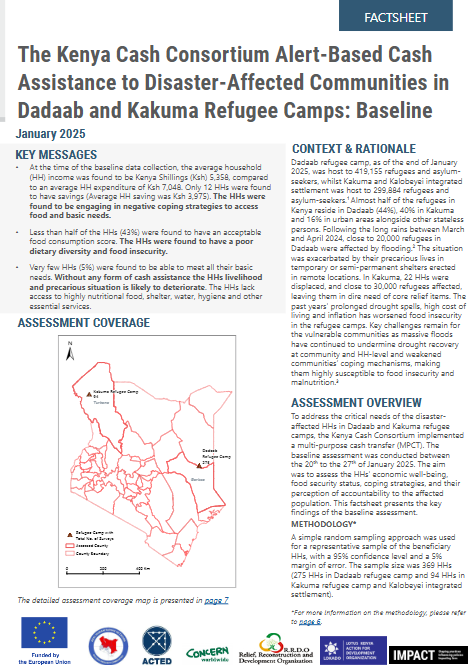ASAL Humanitarian Network (AHN)
BASELINE ASSESSMENT HIGHLIGHTS ECONOMIC STRAIN AND FOOD INSECURITY AMONG REFUGEE HOUSEHOLDS IN DADAAB, KAKUMA, AND KALOBEYEI CAMPS
Baseline Assessment Highlights Severe Food Insecurity in Turkana County
BASELINE ASSESSMENT HIGHLIGHTS ECONOMIC STRAIN AND FOOD INSECURITY AMONG REFUGEE HOUSEHOLDS IN DADAAB, KAKUMA, AND KALOBEYEI CAMPS
In January 2025, the Kenya Cash Consortium conducted a baseline assessment to guide the implementation of the Alert-Based Cash Assistance to Disaster-Affected Refugee Communities in Dadaab and Kakuma Camps project. The study, led by IMPACT Initiatives, surveyed 369 households across Dadaab, Kakuma, and Kalobeyei settlements using a simple random sampling approach with 95% confidence and a 5% margin of error. The aim was to measure household income, expenditure, food security, and coping strategies prior to the rollout of the multi-purpose cash transfer (MPCT).
Findings indicate that refugee households were experiencing significant economic vulnerability at the time of the survey. The average monthly household income stood at KES 5,358, compared to an average expenditure of KES 7,048, leaving most families reliant on borrowing or asset depletion to meet daily needs. Only 5% of households reported meeting all their basic needs, while 71% were in debt with an average liability of KES 7,562.
Food security outcomes were equally concerning. Less than half of households (43%) recorded acceptable Food Consumption Scores, while the remainder showed poor or borderline dietary diversity. The majority of respondents spent over 70% of their income on food, a clear indicator of strained purchasing power and restricted access to essential goods and services.
The assessment highlights the urgent need for flexible, locally-led cash programming to restore household stability and support recovery. Eighty-nine percent of respondents preferred to receive assistance through mobile money transfers, citing safety, flexibility, and autonomy as key benefits.
📄 Click the image below to download the full Baseline Factsheet (PDF) and explore detailed findings, indicators, and coverage maps.

